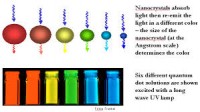LNT Research Group, Department of Physics, QAU, Islamabad, Pakistan

- Modern electronic technology is based predominantly on semiconductor materials. The electrical properties of these materials can be controlled by the selective addition of impurities. Electronic devices are built by manipulating those properties. The fundamental building block of most devices is the transistor. Transistors can be used to amplify electrical signals, or as a solid state on/off switch. Integrated circuits, or computer chips, contain millions of transistors built into a thin wafer of semiconducting material.
- Today, silicon is the material of choice for integrated circuits, but it may not remain so forever. Silicon based devices are an integral part of society, and the market for them is projected to be worth $338 billion in 2012 [1]. The widespread adoption of silicon electronics has largely been enabled by miniaturization, allowing more transistors to fit into the same space and to be used more efficiently. Unfortunately, transistors cannot shrink indefinitely.
- Current high performance integrated circuits contain transistors with dimensions on the order of tens of nanometers. This scale is only about 100 times larger than that of an atom. It would be impossible to build a transistor smaller than an atom, and quantum effects are likely to derail miniaturization even before it reaches that scale. There is thus a fundamental limit to the trend that has driven electronics technology for the past 40 years. New technology will eventually be needed.
- Graphene has been touted as a promising candidate for enhancing the performance of electronics [2]. It consists of a sheet of carbon atoms bonded in a honeycomb pattern. Graphene exhibits electronic mobility around 10 times greater than silicon [2]. Electrical signals can thus propagate through graphene much more quickly than through conventional materials. Electronic devices built from graphene could exploit that property, making them faster than silicon devices of comparable size. In addition, the properties of graphene, like those of silicon, can be controlled, making it possible to build electronic devices with it [3]. Recently, graphene has attracted significant attention, even garnering a Nobel Prize for the pioneers in its study. The graphene field has developed quickly. Although it was first isolated only 7 years ago, operational graphene based electronic devices have been demonstrated.
- Visit for commerical use of Graphene in our life at http://graphenewholesale.com/



